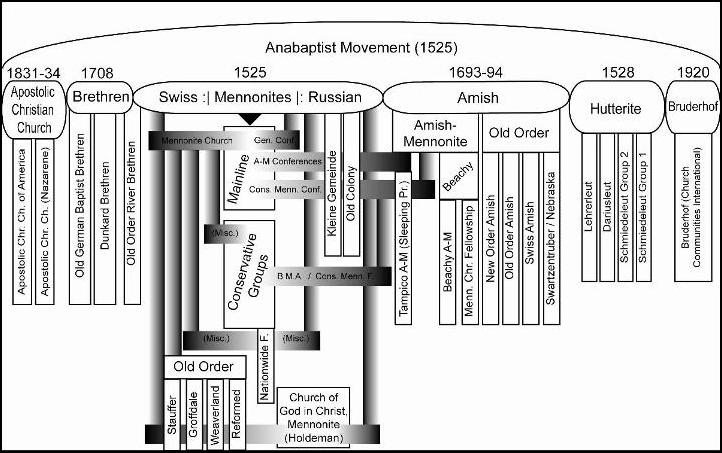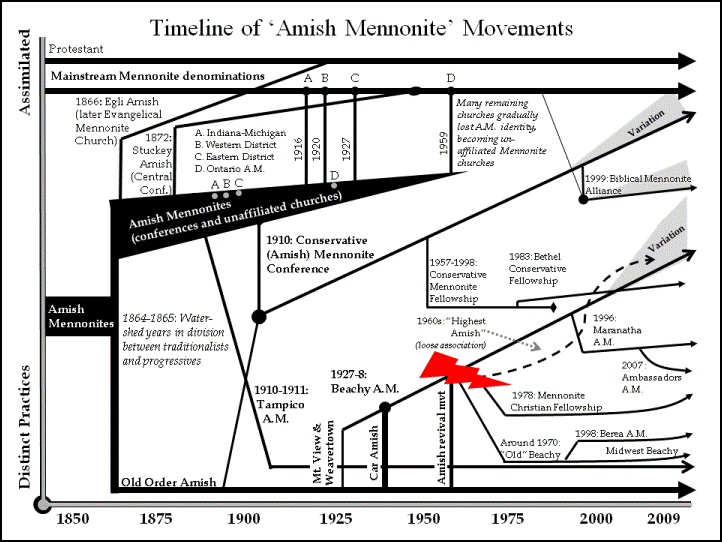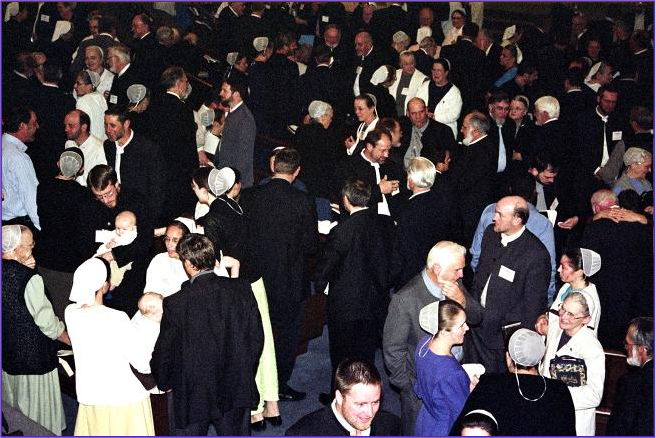


|
Amish-Mennonites and Other Plain Anabaptists |
|
Select Affiliations in the Seven Plain Anabaptist Religious Traditions
This figure shows contemporary grouping of select affiliations. Within the broader umbrella of the Anabaptist movement, originating in 1525, there are seven religious traditions, each developing somewhat separately from the others and with distinctive histories. The religious traditions are the Swiss Mennonites (1525), Russian Mennonites (1536c), Hutterites (1528), Amish (1693-94), Brethren (1708), Apostolic Christians (1831-34c), and Bruderhof (1920). Within the two Mennonite and Brethren religious traditions, there are both plain (Old Order and conservative) and mainstream (non-plain/assimilated) groups. This is especially so among the Mennonites and Brethren. While this figure is far from exhaustive, it gives the viewer an idea of how the different Anabaptist constituencies are nested within these seven plain Anabaptist religious traditions. The horizontal bars represent a period of past movement from one religious tradition to another, most often from Amish-Mennonite to Mennonite and within Swiss and Russian Mennonite traditions. (This figure replaces one previously available at this location, one that represents an earlier phase of this research, available here.) For more information about the different plain Anabaptist groups Ž Download the article, “Who Are the Plain Anabaptists? What Are the Plain Anabaptists” from Vol. 1, Issue 1 of the Journal of Amish and Plain Anabaptist Studies. Ž Purchase Stephen Scott’s book An Introduction to Old Order and Conservative Mennonite Groups. Visit the general library for more information. Ž Visit websites of those plain Anabaptist affiliations that have them. Even though all “plain,” these churches would have a variety of practices and underlying theological emphases. Apostolic Christian Church of America Charity churches Church of God in Christ, Mennonite (Holdeman) Dunkard Brethren Hutterites Old German Baptist Brethren (New Conference) Reformed Mennonite Church South Atlantic Mennonite Conference
|
|
The term “Amish-Mennonite” describes a church or constituency within Anabaptist Christianity that has broken from the Old Order Amish, yet has resisted absorption into a Mennonite constituency or mainstream assimilation. All Amish, including today’s Old Order Amish, were once known as Amish Mennonites. They were literally the Amish type of Mennonite. Today, Amish no longer modifies Mennonite. Rather, “Amish-Mennonite” stands along as a descriptive term. Hence, it is hyphenated. Now, other terms describe Amish-Mennonite, such as the Beachy type, the Maranatha type, the Tampico type, and so on. To avoid confusion, many Amish-Mennonite people identify simply as conservative Mennonites, since anything with the word “Amish” is assumed to go with horse and buggies, no electricity, low technology, and so on. However, the most appropriate term is “Amish-Mennonite.”
First Amish-Mennonite Movement: 1860s(c) to 1920s(c) From 1862-1878, annual conferences were held among the Amish. The conferences produced a number of polarized groups, from which came two primary divisions: the Old Order Amish and the Amish-Mennonites. The Amish-Mennonites formed regional conferences in the late 1880s after the division. They emphasized outward-focused institutional and evangelical programs (Bible schools, Sunday schools, record keeping, meetinghouses, etc.) while the Old Order emphasized the primacy of the community and continuity across generations. During the early 1900s, most of these original Amish-Mennonite groups merged with regional Mennonite conferences. Many of these conferences assimilated into mainstream America in the mid-1900s. These Mennonites no longer dress plain, limit media exposure, or uphold other strict, sectarian practices for which plain Anabaptists are known. Regional Amish-Mennonite Conferences *The Indiana-Michigan Amish-Mennonite Conference began in 1888 and merged with the Indiana-Michigan Mennonite Conference in 1916. *The Western District Amish-Mennonite Conference began in 1890 and merged with the western Mennonite conferences in 1920-1921. *The Eastern Amish-Mennonite Conference began in 1893 and merged with the Ohio Mennonite Conference in 1927. *The Stuckey Amish (Central Conference) of Illinois & Indiana affiliated with the General Conference Mennonites (mainstream) in 1946. *The Egli Amish (Mennonites) became the Evangelical Mennonites (mainstream). Tampico Amish-Mennonite (“Sleeping Preacher”) The Tampico Amish-Mennonites was a group that emerged out of the first Amish-Mennonite movement of the late 1800s. Hence, their history is largely unrelated to the Beachys. This group was influenced by the teachings of John Kauffman, an Amish-Mennonite layman from the late 1800s who preached in a trance. People would assemble at his house in the evening, where he had retired after complaining about convulsions and sickness. When he lay down, his body became stiff, hands clenched tightly. When he preached, the stamina involved amazed people. His attendants would help him to his feet and he would begin to speak loudly, with the introductory words, “I hear thy voice.” While speaking, he had his eyes closed, but walked around the room. When he finished, he said “Amen,” and began to fall backwards, body stiffened. Attendants would help him lay down. He would sleep until morning, claiming to have no knowledge of what had transpired. He preached every evening at first, but then preaching subsided to twice per week. When away from home on preaching missions, he spoke every evening. He was involved in much traveling so his message may be proclaimed. The sources say it is difficult to put his dynamic delivery down on paper, and his charismatic delivery alone commanded authority. He preached a strict traditional Amish ethic, but he also conceived of his role as a prophet, similar to Noah or John the Baptist. Was Kauffman faking it? First hand, non-partisan accounts agree that he was not. Whether Kauffman’s preaching was spirit-led or brought on by health conditions is point of difference. Kauffman was not the only trance preacher among the Amish-Mennonites of this time (though the most well known). There was trance preaching in other denominations as well in this era. Nevertheless, this peculiar practice gained a following, but was rejected by the broader Amish-Mennonite body after initial excitement. Kauffman started a separate congregation with his followers, where he was formally ordained in his final years. Today, there are around 20 churches with around 1,750 members, mostly in the Midwest. The churches use German in services and hold to many conservative practices embraced by the Amish, but allow some modern conveniences, such as electricity and motor vehicles. They reference transcriptions from Kauffman’s sermon, feeling he was a prophet for his time and that he did not contradict Scripture. To read more, download “The Life, Preaching, and Labors of John D. Kauffman” (1916), which includes a biographical sketch and first hand accounts of Kauffman’s teaching. Second Amish-Mennonite Movement: 1910s(c) to 1990s (c) Conservative [Amish]-Mennonite Conference The Conservative Amish-Mennonite Conference was born several decades after the original Amish-Mennonite movement. In 1910, leaders from three unaffiliated Amish-Mennonite congregations met in Michigan to discuss the formation of a conference that allowed for congregational autonomy yet would be able to assist individual churches with problems. This conference was to be more conservative than the above Amish-Mennonite conferences, but not as conservative as the Old Order Amish. Across its 100-some year history, the conference has moved towards assimilation. In 1954, a majority vote called for the removal of the “Amish” part of the Conservative Amish-Mennonite Conference name, which was implemented in the 1957 constitution revision. Proponents suggested that “Amish Mennonite” conferences were obsolete. During the 1960s, concern rose among some about the lax practice on issues such as the women’s head veiling and cut hair, television, and clothing items. Individual churches began to differ greatly in practice. Since the concerns in the 1960s, conference has abandoned a stand on the aforementioned practices and is today mainstream. Website: Conservative Mennonite Conference– Rosedale, OH Ontario Amish-Mennonite Conference The Ontario Amish-Mennonite Conference organized in 1923. They dropped the word “Amish” in 1963, becoming the “Western Ontario Mennonite Conference.” Many of the changes in the Ontario A-M Conference paralleled those taking place in the Conservative A-M Conference. In 1988, they merged with mainstream Mennonites. Biblical Mennonite Alliance The Biblical Mennonite Alliance, or BMA, resulted from a split with the Conservative Mennonite Conference (CMC). In a 1999 meeting, CMC took a vote that failed to uphold the required practice of the woman’s veiling. This was the final straw in a series of issues that increasingly alienated conservative congregations within the conference. These churches broke from CMC and formed BMA. BMA retains a governmental body similar to CMC and individual congregational practice still varies widely. While BMA has Amish-Mennonite origins and roots, most members of BMA would not think of themselves as Amish-Mennonite. While they are a conservative Anabaptist group, their strictness in dress, technology, and so on is probably lowest of all plain Anabaptist groups. Website: Biblical Mennonite Alliance Third Amish-Mennonite Movement: 1920s(c) to present, the Beachy Amish-Mennonites The largest contemporary Amish-Mennonite group is the Beachy Amish-Mennonites. The Beachy constituency received its name from Moses Beachy, an Old Order Amish bishop in Somerset County, PA. Beachy refused to administer the Streng Meidung (strong ban) against members. That is, anyone who left for a less conservative group, such as the nearby Conservative Amish-Mennonite congregation, would be shunned. Half the congregation sided with Beachy, and the other half sided with his two co-ministers. Beachy's congregation affiliated with an Amish-Mennonite congregation in Lancaster County, the Weavertown Amish Mennonite church, that had divided in 1909-10 from the Amish over the Streng Meidung as well. During the 1940s, a number of other factions emerged in Ohio, Indiana, Illinois, Iowa, Kansas, Oklahoma, and Virginia from Old Order Amish groups. The congregations sought affiliation with the Beachy constituency. These churches were literally Amish with cars and electricity, and without the Streng Meidung. In the 1950s-1960s, a group of evangelically-minded Amish withdrew from the Old Order and started working with Beachy churches, which were also becoming more evangelical. During this era, many mission programs and nurture ministries were established, but it also began a long struggle between the religious autonomy of individual souls (emphasized by evangelical beliefs) and the authority of the religious community to direct members in a host of practices that kept a high standard of holiness and separation from mainstream society. Gradually, over the past several decades, distinctive practices have been abandoned, much as had happened with the past two generations of Amish-Mennonites. Will the Beachys assimilate as well? Only the future can tell. Today, the Amish-Mennonite churches that come out of the Beachy movement vary widely in practice. The constituency is a fellowship, so each church exercises considerable congregational autonomy. Most have retained at least some conservative, plain practices, but this is increasingly questioned, especially in older churches and churches in predominantly Old Order Amish areas. New standard allowances in the more relaxed congregations include recreational use of the computer/internet, sports competitions, musical professionalism , and DVD-based entertainment. Clothing is also less distinct in these congregations, especially among the men. Women's dress, as well, has become less distinguishable and coverings have undergone abbreviation or alteration in styles to permeable and fashion-conscious forms. Other Beachy churches have rejected all of these changes, yet still struggle addressing these issues. Today, there are around 15,000 adherents in 175 churches in the United States, Canada, Mexico, El Salvador, Nicaragua, Costa Rica, Paraguay, Australia, Ireland, Ukraine, Romania, Kenya, and Liberia, with associated churches in several other countries. More information: Ž Global Anabaptist/Mennonite Encyclopedia Online article Ž Just keep browsing this website! Amish-Mennonite Subgroups Emerging from the Beachy Movement Churches more cautious in accommodating societal pressures have gradually drifted out of the Beachy Amish-Mennonite fellowship and have established independent fellowships. Most of these are constitution based, signifying that they agree to uphold certain practices (such as in dress, technology, and media) in order to be part of the group. Forty-some congregations have formally developed closer knit fellowships with specific direction, organization, and goals. These churches may still be connected to the Beachy constituency through informal ties and cooperation in some programs, such as mission work, but have become independent affiliations with their own set of programs. They are listed in order of strictness/conservatism (least to greatest). Maranatha Amish-Mennonite Churches Maranatha was birthed in July 1997. It was started out of a concern for the direction and changes within Beachy congregations. Of particular concern to Maranatha leaders was “the perceived lack of accountability to each other, including an inability to address and correct problems and in the casual way church divisions are handled.” Maranatha churches are more conservative than Beachy. Maranatha holds a separate annual Ministers’ Fellowship Meeting. Several networks of Maranatha congregations hold annual Area-Wide Bible Schools each winter. These provide an alternative to the institutional Bible school of the Beachys, which tends to nurture a stronger youth-based peer culture. Area-wides are hosted by local congregations. Today, there are around 2,000 adherents in around 20 churches in the United States and Canada. More information: Ž Maranatha Amish-Mennonite constitution. Ž Global Anabaptist/Mennonite Encyclopedia Online article Ambassadors Amish Mennonite Ambassadors formed as a small network of churches, instigated by the Leitchfield and Summersville congregations of Kentucky. They had originally been with the Maranatha congregations, but desired a more intimate fellowship. Ambassadors has a strong emphasis on rapid successive church planting in areas with no Anabaptist witness. Ambassadors holds a separate semiannual Ministers’ Fellowship Meetings and holds an annual area-wide youth Bible school with a host congregation. Their largest project is Beside the Still Waters, a daily devotional published in two month increments. Still Waters has a circulation of around 200,000 the largest of any plain or mainstream Anabaptist publication. Today, there are around 750 adherents in a little under 10 churches in the United States. More information: Ž Ambassadors Amish Mennonite Fellowship constitution Ž Global Anabaptist/Mennonite Encyclopedia Online article Mennonite Christian Fellowship The Mennonite Christian Fellowship churches, or just “Fellowship churches,” originated from several congregations separating primarily from the Amish in the 1960s. They were latecomers to the Amish mission movement (discussed above) and received assistance from the churches that left the Amish for the Amish-Mennonites in the previous decade. When the earliest mission-minded Amish-Mennonites decided to merge with the Beachy Amish-Mennonite churches, these latecomers opposed the merger. They felt the Beachys were too lax on some practices at that time, such as permitting tobacco (which is no longer so), beginning institutions that permit too much youth culture (voluntary service units and Bible schools), and relaxing dress standards. In 1978, these churches started holding separate annual Ministers’ Meetings. Today, there are around 3,000 adherents in around 40 churches in the United States, Honduras, Nicaragua, Costa Rica, Cuba, and Paraguay More information: Ž Global Anabaptist/Mennonite Encyclopedia Online article Berea Amish-Mennonite Churches Berea Amish Mennonite churches began meeting in 1998 for annual ministers’ meetings. A constitution was drafted and approved in August of 2008. Like Maranatha, Berea churches share a concern for the direction of the nucleus Beachy churches and the way church divisions are handled. Berea is more conservative than Maranatha or Ambassadors, but not as conservative as Midwest Beachy. Berea holds a separate annual Ministers’ Fellowship Meeting and holds an annual youth fellowship meeting with a host congregation. Today, there are around 1,000 adherents in over 10 churches in the United States and Belize. More information Ž Berea Amish Mennonite Fellowship constitution Ž Global Anabaptist/Mennonite Encyclopedia Online article Midwest Beachy Amish-Mennonite This is the most conservative of the subgroups. There is no formal structure knitting the congregations together other than an annual school meeting and their branch of the Conservative Anabaptist Service Program. Midwest Beachy is the most conservative of the Amish Mennonite groups; for example, they would use the German language in their services, and this is a defining trait of their group. Today, there are around 750 adherents in six churches. More information: Ž Global Anabaptist/Mennonite Encyclopedia Online article Other Amish-Mennonite Congregations A number of other Amish-Mennonite congregations exist in an independent, unaffiliated setting. They commonly self-identify as conservative Mennonite and may associate with Beachy or conservative Mennonite churches. Most have roots in the Beachy movement, although a handful would remain from the first Amish-Mennonite movement of the late 1800s. Today, there are around 3,500 adherents in around 40 churches in the United States and Canada.
|
|
Timeline of Amish-Mennonite Movements
This chart shows three periods of Amish-Mennonite movements: 1800s through early 1900s (regional conferences), the early to late 1900s (Conservative Conference), and the mid-1900s to present (Beachy). Prior to the mid-1800s, all Amish (Old Order and Amish-Mennonites) were a single group. The red bolt in the Beachy line represents a period of identity crisis, from which came several offshoots. This chart does NOT show changes and diversity among the Old Order Amish or Mennonites. |








































































